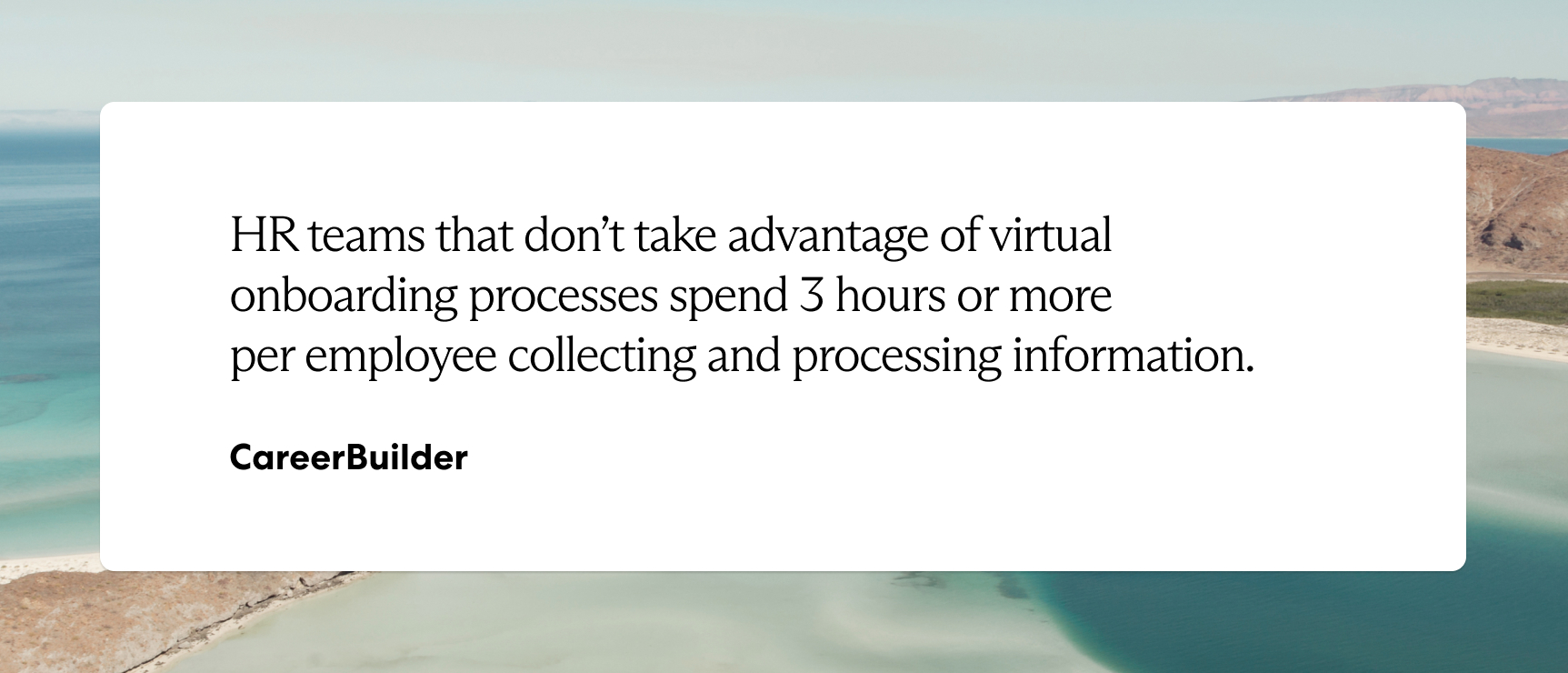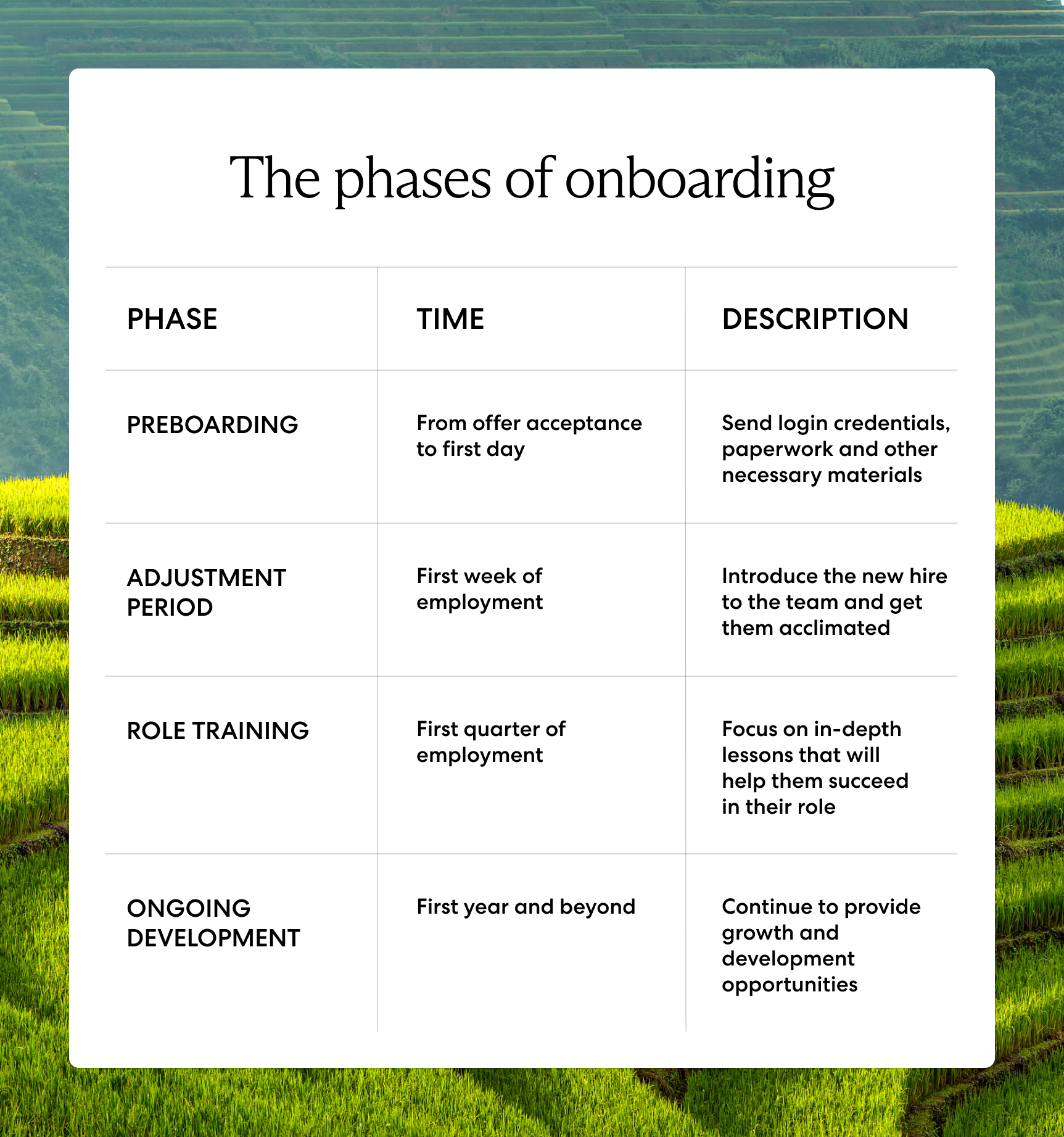Virtual onboarding allows organizations to enjoy unprecedented flexibility and efficiency throughout the process of bringing aboard new talent while reducing employee churn.
This strategy also allows companies to easily source remote talent from anywhere across the globe. As a result, virtual onboarding has become the new normal in the growing world of distributed work.
Below, we define virtual onboarding in greater detail, list the benefits HR teams enjoy by adopting this strategy, and provide key considerations to keep in mind when making the transition from in-person onboarding practices to virtual onboarding.
What is virtual onboarding?
Virtual onboarding is the process of remotely onboarding new hires with the help of an online platform. By onboarding talent virtually, HR teams can complete the traditional onboarding steps more efficiently than they can via traditional onboarding—and without the time and resource constraints of in-person orientation.
Through virtual onboarding, HR teams can provide new hires with the critical information necessary for comfortably transitioning them into their new role while taking advantage of numerous additional benefits.
What are the benefits of virtual onboarding?
Virtual onboarding offers HR teams various benefits, like time-savings, flexibility, efficiency, employee empowerment, and access to a broader talent pool.
Remember that online onboarding is not only beneficial to exclusively remote teams. By adopting virtual onboarding, hybrid teams can also shift the pressure off of HR and hiring managers and enjoy all of the benefits outlined below.
Saves time
Virtual onboarding eliminates the need for spending time and resources setting up in-person events to orient new employees, such as traveling and organizing office space.
Throughout the remote onboarding process, HR teams can organize remote meetings, quickly distribute informational materials, and promptly answer questions through virtual platforms.

Adds flexibility
The virtual environment of online onboarding offers an invaluable degree of flexibility, which is especially useful for large teams with multiple new hires in different job roles.
Through virtual onboarding, HR teams can promptly adapt, make changes in the onboarding process for individual hires, and quickly distribute those changes to relevant team members.
For example, if crucial information is missing at any stage of the onboarding process, you can quickly update documents and learning modules remotely from any computer with an internet connection and promptly distribute the updates.
Empowers new hires
Through online onboarding, HR teams can offer new hires training modules designed for their specific role available for them to watch anywhere and at any time.
By allowing your virtual employees to complete the onboarding process at their own pace, employers eliminate stress and time constraints associated with rigid onboarding schedules, providing new hires with a sense of empowerment as they enter their new roles.
Simplifies HR tasks
Through a virtual onboarding process, HR teams can easily create, store, and share onboarding documents for each new employee, such as offer letters, employment contracts, payroll and benefits documents, and more—all in one place.
Facilitates global hiring
One of the primary benefits of virtual onboarding is that it enables companies to tap into the global talent pool, source employees with various backgrounds and skill sets beyond borders, and seamlessly onboard them through virtual processes.
For example, ride-sharing companies like Uber often hire tens of thousands of employees around the world each month. By onboarding international employees virtually, HR teams at Uber can automate each onboarding phase and offer remote trainings for each employee in their own language.
Without virtual onboarding, building a remote team can be a logistical headache.
Phases of the virtual onboarding process
Each onboarding phase is critical for your team’s success, from creating email and project management accounts for new hires to identifying upskilling opportunities months after an employee joins your company.
Below we outline each virtual onboarding phase in detail.

Preboarding
Preboarding begins the moment your candidate accepts the job offer. At this stage, your HR team must take several critical steps to nurture your new hire’s excitement to join the company and set them up for success.
For example, consider sending out digital or physical welcoming packages and company merchandise like mugs and t-shirts.
During this time, deliver important office equipment, such as work laptops, to your new employee, and have them provide critical payroll and security documentation. Create their accounts for email, communication software, project management software, and other company tools.
Also, notify your internal team of the new employee’s start date, explain their role in the company, and assign a teammate as their buddy or mentor.
Adjustment period
During their first week, focus on helping your new employee adjust to their role and familiarize themselves with the company and their colleagues.
Have your new hire complete IT onboarding, and send them invites to recurring team meetings. Introduce them to their managers, colleagues, and anyone they will interact with daily.
Consider using this time to make your company culture shine by getting your new employee involved with aspects of your company beyond the workday, such as a virtual lunch or remote game night.
Role training
Your new hire’s first month involves role-specific training to help them grasp the responsibilities of their new role. This process involves getting into the nitty-gritty of their job duties and providing them with specific, in-depth lessons.
Use this time to guide them, answer questions, and provide focused support as they learn how to use company tools and perform their duties.
Consider offering video recordings, training documentation, and other supplemental cloud-based training support they can access at any convenient time.
Ongoing development
Once your new employee is fully trained and working independently, continue nurturing their performance, engagement, and development by offering ongoing support.
The easiest way managers can help their employees grow is by hosting regular virtual meetings to check in on their development and discuss their career goals.
Help them set actionable goals, identify areas where employee upskilling could be beneficial, establish a career development plan indicating how and when they can get promoted, and schedule training sessions focusing on skill development.
Ongoing employee development is a crucial part of an employee retention strategy.
Virtual onboarding best practices
To ensure a smooth transition as you shift to virtual onboarding, keep in mind some best practices, such as giving new hires early access to important resources, communicating your expectations from day one, and onboarding in groups.
Below we outline seven key virtual onboarding best practices in detail.
Read more: 11 Unique Onboarding Ideas for Remote Employees
1. Give new hires early access to resources and tools
Help facilitate a smooth transition to their new role by ensuring new employees are fully prepared for their first day on the job before it arrives.
During the preboarding phase, deliver all essential physical items to your new employee, such as welcoming packages, work laptops, physical or digital copies of the company handbook, training manuals, and job descriptions.
Set up your new hire’s accounts for all company tools and deliver their login details along with invitations for first-day meetings before they start.
2. Communicate expectations and agendas before day one
While setting up accounts and delivering company equipment is essential, clearly communicating to new employees what they can expect on their first day on the job is equally important for reducing their anxiety and ensuring they feel set up for success.
For example, the hiring manager could send a message to the new employee’s personal email regarding the first day’s agenda, informing them when and where to sign on in the morning, and providing all video call links for important first-day meetings.
3. Onboard new hires in groups if possible
When hiring multiple employees within the same department or in similar roles, consider pairing new hires together on the first day of meetings.
Naturally, since new hires can easily relate to one another, they feel less intimidated in groups and easily find a support system in each other to lean on as they learn and grow.
Pairing new employees together creates an excellent opportunity for them to strengthen connections with other employees from day one.
4. Schedule welcome meetings with team members
Whether your team is fully remote or hybrid, remember to set up meetings between your new hires and their colleagues from day one.
These meetings allow new employees to build connections from the start, which is critical for helping them feel comfortable at the company and become engaged with their job duties.
If you work with a distributed team, there are several ways to introduce new hires to their teammates.
For example, post a friendly welcome message on a “Welcome to the Team” Slack channel with information about the employee, and give your new employee a list of teammates with whom they should schedule introductory calls.
5. Implement regular check-ins
The first weeks and months in a new role are as unnerving as they are exciting, and your new hire will likely have several questions during this time.
Set aside time for regular one-on-one meetings. Ensure they know you are available to them and are a reliable resource as they familiarize themselves with their new role. Encourage them to come to check-ins prepared with a list of questions or issues they want to clarify.
Ensuring your new employees know you are a reliable resource from the start also builds trust.
6. Use various learning methods
Virtual onboarding can be a lonely time, negatively affecting your new hire’s ability to fully adapt to company processes, connect with teammates, and retain information.
Help them engage by diversifying the onboarding process with various activities, different media formats, and unique self-led learning modules. For instance, offer company-produced videos with explainers, product tutorials, and client interviews, or host collaborative video meetings.
Consider having your new hire create an introduction video or answer several inspiring questions about their life goals and aspirations to share with the team.
7. Ask for feedback
To improve the virtual onboarding process, remember to ask employees for feedback on their onboarding experience roughly three months after joining your organization.
HR managers can do this in various ways, such as by conducting video interviews or sending out surveys consisting of multiple choice, sliding scale, and open-ended questions.
Below are examples of some open-ended questions you can ask your employees:
- What phases of the onboarding process lacked important information?
- During which phase did you feel the most engaged?
- At what point did you feel frustrated? Why?
Asking for feedback also helps build trust with new hires, as it demonstrates that you value their opinions.
Virtual onboarding FAQs
Below we answer commonly asked questions about virtual onboarding.
What is the difference between virtual onboarding and onboarding?
The main difference between virtual onboarding and traditional onboarding is the setting: Virtual onboarding takes place remotely and online for one or both parties, while traditional onboarding typically takes place in person for both parties.
How do I prepare for virtual onboarding?
Consider the following tips to help you prepare for virtual onboarding:
- Check that your technology and internet connection are reliable.
- Make sure your workspace area is free of noise and distractions.
- Send a detailed schedule to your new hire at least one day before onboarding begins.
- Ensure all necessary tools and documents are readily accessible.
- Mute any messaging or phone notifications you may receive during onboarding.
- Prepare some ice-breaker questions or activities to make your new hire feel at ease.
Streamline virtual onboarding with Velocity Global
Virtual onboarding empowers companies to reduce turnover and source employees from a wider talent pool. However, many companies don’t know where to start. Eliminate the stress by partnering with Velocity Global.
As an employer of record (EOR), Velocity Global offers dedicated onboarding assistance for companies in any sector, especially those sourcing remote international talent.
Lean on us to draft compliant employment contracts in over 185 countries, gather proper employee tax documents, and set up country-specific payroll and benefits on your behalf so you can grow your team without the added burden.
Our Global Work Platform™ automates onboarding workflows, is customized to suit country-specific needs and regulations, integrates with your existing HRIS solutions, and offers you full visibility and control throughout every step.
Contact Velocity Global today to learn how to simplify onboarding and grow your team beyond borders with ease.
Topic:
HR Strategies



